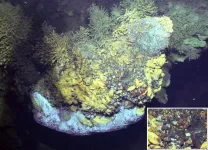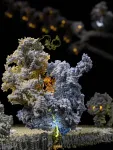(Press-News.org) China is just one of many countries in the Northern Hemisphere having what researchers are calling an "extremely cold winter," due in part to both the tropical Pacific and the Arctic, according to an analysis of temperatures from Dec. 1, 2020, to mid-January of 2021. A country-specific case study, the investigation potentially has far-reaching implications for predictions and early warnings to protect against harmful impacts, researchers said.
The results were published online, ahead of print, on Feb. 12 in Advances in Atmospheric Sciences.
"We are trying to explain why the countries in the Northern Hemisphere more frequently encounter the extremely cold events against a global warming background, and we chose the 2020-21 extremely cold winter in China as a case study," said co-first author Fei Zheng, International Center for Climate and Environment Science (ICCES), the Institute of Atmospheric Physics (IAP) at the Chinese Academy of Sciences (CAS).
Since Dec. 1, 2020, the lowest temperatures in 58 cities, including Shanghai and Beijing, either broke or set records. On average, temperatures are at least one to two degrees Celsius below normal across the country, with some areas reporting temperatures as much as four degrees Celsius below average.
According to Zheng, two events thousands of miles from China are responsible: warming in the Arctic and cooling in the tropical Pacific, near the equator. Arctic warming results in melting ice, disrupting surface and ocean temperatures. La Niña, the cool phase of the tropical Pacific's extreme climate cycles, drops ocean temperatures to -5 degrees Celsius and displaces atmospheric and global wind circulation.
"The synergistic effect of the warm Arctic, mostly induced by global warming, and the cold tropical Pacific, caused by La Niña, intensified the intrusions of cold air from polar regions into mid-high latitudes, which further influenced the cold conditions in China during the first half of winter 2020-21," Zheng said. "This synergistic effect can be regarded as a necessary background for triggering the cold surges invading most countries in East Asia and North America."
To forecast the evolution of La Niña in particular, the researchers used the ensemble prediction system developed at IAP, CAS. The system assesses the last 20 years of a selected climate event and offers a prediction of up to a year on how that event might evolve.
"The most recent ensemble forecast suggests that there is at least a 95% chance that La Niña will persist through the 2020-21 winter, with a potential transition to a neutral standing during the spring," Zheng said, noting that there is still some uncertainty when it comes to winter predictions. "People should focus on weather forecasts and the latest predictions for atmospheric circulations to obtain the necessary date information and early warnings. We still need to pay attention to the possible large temperature fluctuations and increased snow and rainfall in China during the late winter."
Researchers plan to further study the synergistic effect of extreme climate events through observation, climate simulation and data assimilation with the ultimate goal of improving seasonal predictions for countries in the Northern Hemisphere.
INFORMATION:
Zheng is also affiliated with the Collaborative Innovation Center on Forecast and Evaluation of Meteorological Disasters, Nanjing University of Information Science & Technology. Other contributors include co-first author Yuan Yuan, Yi-Hui Ding, Yu-Heng Zhao, Zong-Jian Ke and Xiao-Long Jia, National Climate Center, China; Ke-Xin Li, Yue Sun and Jiang Zhu, ICCES, IAP, CAS; Xiang-Hui Fang, Department of Atmospheric and Oceanic Sciences & Institute of Atmospheric Sciences, Fudan University; and Ji Wang, Beijing Municipal Climate Center. Li and Zhu are also affiliated with the University of Chinese Academy of Sciences.
The national Key R&D Program of China, the Key Research Program of Frontier Sciences, CAS and the National Natural Science Foundation of China funded this work.
Nanoparticles used in drug delivery systems, bioimaging, and regenerative medicine migrate from tissues to lymphatic vessels after entering the body, so it is necessary to clarify the interaction between nanoparticles and lymphatic vessels. Although technology to observe the flow of nanoparticles through lymphatic vessels in vivo has been developed, there has been no method to evaluate the flow of nanoparticles in a more detailed and quantitative manner ex vivo. Thus, research was conducted to develop an ex vivo lymphatic vessel lumen perfusion system to determine how nanoparticles move in lymphatic vessels and how they affect the physiological movement of lymphatic vessels.
Nanoparticles introduced into the ...
A research team led by Prof. QIAN Peiyuan, Head and Chair Professor from the Hong Kong University of Science and Technology (HKUST)'s Department of Ocean Science and David von Hansemann Professor of Science, has published their cutting-edge findings of symbiotic mechanisms of a deep-sea vent snail (Gigantopelta aegis) in the scientific journal Nature Communications. They discovered that Gigantopelta snail houses both sulfur-oxidizing bacteria and methane-oxidizing bacteria inside its esophageal gland cells (part of digestive system) as endosymbionts. By decoding the ...
A new study looking at how COVID-19 affects people with asthma provides reassurance that having the condition doesn't increase the risk of severe illness or death from the virus.
George Institute for Global Health researchers in Australia analysed data from 57 studies with an overall sample size of 587,280. Almost 350,000 people in the pool had been infected with COVID-19 from Asia, Europe, and North and South America and found they had similar proportions of asthma to the general population.
The results, published in the peer-reviewed END ...
Researchers at the University of Illinois Chicago have discovered a way to convert the methane in natural gas into liquid methanol at room temperature.
This discovery, reported in the journal Proceedings of the National Academy of Sciences, could potentially provide a cleaner energy source for many of our everyday activities.
When burned, natural gas -- the fuel used to heat homes, cook food and generate electricity -- produces carbon dioxide, a powerful greenhouse gas.
According to the U.S. Energy Information Administration, the U.S. consumed approximately 31 trillion cubic feet of natural gas in 2019, contributing roughly 1.6 gigatons of carbon dioxide to the atmosphere.
A better way to use natural gas would be to convert it to methanol, a liquid fuel that burns more ...
University of Queensland scientists have developed an ultraviolet 'television' display designed to help researchers better understand how animals see the world.
Until now, standard monitors on devices like televisions or computer screens have been used to display visual stimuli in animal vision studies, but none have been able to test ultraviolet vision - the ability to see wavelengths of light shorter than 400 nanometres.
Dr Samuel Powell, from the Queensland Brain Institute's Marshall lab, said this new technology will help unveil the secrets of sight in all sorts of animals, such as fish, birds and insects.
"Human TVs generally use three colours - red, green and blue - to create images, but our newly-developed ...
Mitochondria are organelles that act as the powerhouses in our body. They use oxygen which we inhale and food we eat to produce energy that supports our life. This molecular activity is performed by bioenergetic nano-factories incorporated in specialized mitochondrial membranes. The nano-factories consist of proteins cooperatively transporting ions and electrons to generate chemical energy. Those have to be constantly maintained, replaced and duplicated during cell division. To address this, mitochondria have their own bioenergy protein-making machine called the mitoribosome. Given its key role, a deregulation of the mitoribosome can lead to medical disorders such as deafness and diseases including cancer development. The first fundamental understanding of how mitoribosomes ...
A POSTECH-KAIST joint research team has successfully developed a technique to reach near-unity efficiency of SHEL by using an artificially-designed metasurface.
Professor Junsuk Rho of POSTECH's departments of mechanical engineering and chemical engineering, and Ph.D. candidate Minkyung Kim and Dr. Dasol Lee of Department of Mechanical Engineering in collaboration with Professor Bumki Min and Hyukjoon Cho of the Department of Mechanical Engineering at KAIST have together proposed a technique to enhance the SHEL with near 100% efficiency using an anisotropic metasurface. For this, the joint research team designed a metasurface that transmits most ...
Photo and map
Robotic laboratories on the bottom of Lake Erie have revealed that the muddy sediments there release nearly as much of the nutrient phosphorus into the surrounding waters as enters the lake's central basin each year from rivers and their tributaries.
Excessive phosphorus, largely from agricultural sources, contributes to the annual summer cyanobacteria bloom that plagues Lake Erie's western basin and the central basin's annual "dead zone," an oxygen-starved region that blankets several thousand square miles of lake bottom and that reduces habitat for fish and other organisms.
The release of phosphorus from Lake Erie sediments during periods of low oxygen--a phenomenon known as self-fertilization or internal loading--has been acknowledged since the 1970s. ...
We are most familiar with the four conventional phases of matter: solid, liquid, gas, and plasma. Changes between two phases, known as phase transitions, are marked by abrupt changes in material properties such as density. In recent decades a wide body of physics research has been devoted to discovering new unconventional phases of matter, which typically emerge at ultra-low temperatures or in specially-structured materials. Exotic "topological" phases exhibit properties that can only change in a quantized (step-wise) manner, making them intrinsically robust against impurities and defects.
In addition to topological ...
Despite our great progress in understanding various cellular mechanisms over the last decades, many of them remain unclear. Such is the case for exosomes, small vesicles released by cells that contain genetic materials called "RNA" and various proteins. The roles of exosomes are believed to be very varied and important, both for normal bodily functions and also in the spreading of diseases like cancer. However, exosomes are so small that studying them is challenging and calls for costly and time-consuming techniques, such as electron microscopy (EM).
To tackle this issue, a team of undergraduate students from ...





